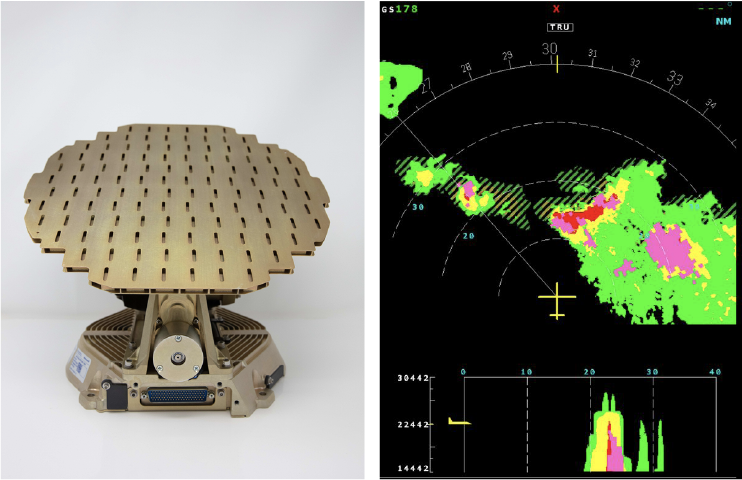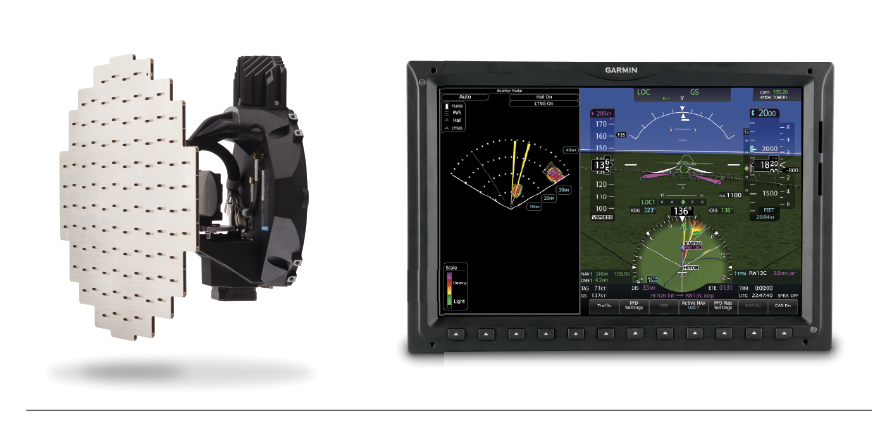“Conversation about the weather (radar) is the last refuge
– Oscar Wilde, Irish Dramatist
of the unimaginative.”
Obviously, Mr. Wilde was not a pilot – well, at least not a pilot that did any serious instrument flying. If he were, he’d have a much greater appreciation for the safety-enhancing capabilities offered by airborne weather radar.
When properly operated, airborne weather radar gives pilots the best possible, real-time view of the position and severity of any precipitation between the nose of their aircraft and the intended destination.
I say “intended” because the real value of live radar is helping you plan a safe deviation track around said weather. The stronger the precipitation return, the wider the berth. Believe me, heavy rain, hail and associated areas of wind shear and turbulence have brought down bigger airplanes than any of us are flying.
Radar is all about weather avoidance, so when in doubt, heed the old sailor’s warning: “Thar’ be dragons out thar’…”

Monochrome and Magnetrons
There’s no debate that today’s weather radar systems are marvels of capability and simplicity. Digital technologies have enabled manufacturers to add a host of safety-enhancing functions, including turbulence, hail, lightning and predictive wind shear detection capabilities into many of today’s new-generation systems.
But, before we dive deeper into what the new generation of radars can do for you today, let’s go back to when all the weather was monochrome green.
Radar had been around for a long time, but it took a few leaps in manufacturing technologies to shrink the antenna, magnetron, and all the associated mechanicals and electronics down to where it would fit in the front of even a large airliner.
Bendix Avionics (now Honeywell/BendixKing) introduced the first commercial airborne weather radar, its RDR-1, in 1956. The ability for pilots to see rain, and thus avoid turbulence, garnered so much popular press that airlines and aircraft manufacturers went so far as to tout “Radar Equipped” in advertising and on the sides of their aircraft.
“The magnetron is a very high-powered device that’s very similar to what you’d find in an old-style tube TV,” explained Dr. Joel Andrews, team leader design engineering, Garmin Aviation. “And just like those old TVs, the old weather radars had to warm up when you turned them on. They also had issues with the magnetrons losing power and the screen images getting dimmer over time.”
That meant that the airlines were having to change out the magnetrons and some of the receiver/transmitter antenna’s mechanical systems every 500 to 600 hours. But, when they also had to swap out a big radial engine every month or so, it wasn’t that big of a deal.
Then along came the Jet Age, and everything changed. Faster aircraft meant that radars had to show weather at longer ranges and with a higher degree of accuracy. And, the fact that jet engines operated for thousands of hours put pressure on radar manufacturers to develop more reliable hardware.
As technology evolved, so did the reliability, consistency and signal clarity of the magnetrons. In fact, many current-generation weather radar systems still rely on them to generate their beam energy. You’re probably flying with one right now.
Less Power, Better Processing
“We actually used the magnetron in our first radar, the Garmin GWX68,” Andrews says. “It had 6.5 kilowatts of transmit power at 5,000 volts. It’s not something you want to mess with. They were all very high-power units.”
And that high-power requirement was one reason that the magnetrons powering the legacy-generation radar systems had such short lifespans. The solution was to transition to new-generation magnetrons or, better yet, switch to solid-state designs, which was a change that you would expect to have been met with great joy. Well, not so much…
The fact of the matter was, with 6.5 kilowatts of transmitter power, the old analog type radars did a fine job of punching electronic holes in storms, so pilots could see what was inside. While this was good, it wasn’t without its drawbacks. In some instances, they’d actually give a false impression of the severity of the storm, which led more than one unsuspecting pilot to fly into areas they shouldn’t have.
“It’s a hard thing for people to get their minds around, but our new-generation systems like the GWX70 and GWX80 only use 40 watts of transmit power,” Andrews continued. “They think lower power means less performance, but what it comes down to is the difference between raw transmitter power and advanced digital processing.”
“What we do with the lower-power, solid-state systems is to use longer pulses and digital processing on the waveform to put the same, if not more, energy on the target,” he says. “Even though we are using a lot less power, we are getting better weather depicting performance from the unit.”
Along with an equal-to, or better-than a magnetron image, today’s radars are a lot more reliable than their Neolithic ancestors.
“As you can imagine, as we go from legacy magnetron-based systems to fully solid-state units, we get a huge spike in the reliability,” stated Vipul Gupta, product line leader, weather radar, Honeywell/BendixKing. “Of course, it’s a bit dependent on the aircraft type, but we are seeing reliability increasing two or three times – up to 16,000 to 20,000 hours MTBF.”
While the dramatic increase in reliability was a driving factor for the manufacturers to begin the switch to digital, solid-state technology, it was just the beginning of the benefits the new format would deliver.
“One of the immediate benefits of digital radars was doppler processing, which is really hard to do with a magnetron. With digital signal processing, you are transmitting exactly the same frequency pulse every time,” Andrews says. “It’s incredibly repeatable, so you can create a more accurate, consistent weather return.”
“That display consistency is one of the first things a pilot will notice about a new solid-state radar versus an old magnetron-based system. Magnetron units can vary or drift – they’re very inconsistent – some pulses are super-hot or off-frequency so the image can change from one sweep to the next,” he continued. “Not so with digital. The picture is very consistent, which makes it easier for the pilot to interpret what the weather really looks like.”

Many Happy Returns
A sharper, more detailed display isn’t the only benefit solid-state technology and advanced signal processing bring to onboard weather radar. As you no doubt know, doppler capabilities have opened the door to many other ride- and safety-enhancing features.
“Providing hazardous weather avoidance information is a major benefit of solid-state radar,” Gupta says. “Hail, turbulence, predictive wind shear and lightning are all hazards modern radars can help pilots avoid. We also have a built-in terrain database in our larger systems that can automatically remove ground-clutter from the display. That further enhances the weather picture.”
Ground clutter returns have always been a major headache for pilots. Tweaking that antenna tilt just right to get all the precipitation without false ground returns can drive you to distraction. Never a good thing in an aircraft’s cockpit. No matter what the weather.
To help eliminate the problem, and reduce pilot workload, many newer radars feature an automatic tilt control function of one form or another.
“Our newest radar, the GWX80 has an Auto Mode, which is extremely sophisticated. It’s a set-and-forget type system,” Andrews explained. “You just turn it on, and the system will set the antenna at the optimal view of the air in front of the aircraft. Pilots
really love it.”
It does, of course, have a manual tilt control for instances when pilots want to pitch the antenna up to get a view of weather above their aircraft: Especially when they suspect hail to be involved. As you might guess, this can be as challenging as tilting downward to remove ground clutter.
Yet again, digital technology is providing a solution in the form of the Vertical Profiling capability found on many of BendixKing’s new-generation radars.
“In a normal scan, we are looking at the entire volume air of front of the aircraft that is sliced into lateral pieces, and the radar displays it in a top-down view,” Gupta stated. “With vertical profile, we can slice it along the azimuth so you can see the vertical signature of the precipitation within that cell. Hail above the aircraft can be very dangerous.”
“We had a pilot flying a Falcon 8X recently. They were at FL450 and the vertical profile was painting a supercell topping off at over 60,000 feet,” he continued. “Needless to say, they planned a deviation course well around that cell.”
Navigating Your Digital Radar Upgrade Path
No doubt that with all of the new-generation features and benefits they provide, upgrading to a solid-state radar system is high on every pilot’s wish list. But, as you may well expect, not all features are available in all radar systems. A big determiner is the size of the radar antenna that your aircraft can accommodate.
The larger the antenna diameter, the more returning pulses the system can collect. And it’s those returning pulses that the system uses to create the display. More pulses equal a more accurate display. Of course, along with the size of the antenna, there’s also the avionics you currently have in your panel to consider.
“If you want to upgrade to some higher-level features like ground clutter suppression, turbulence, and hail and lightning prediction found in our Garmin GWX70 or GWX80, you need to have at least a Garmin GNS display. If you have G1000, then it’s an easy upgrade,” Andrews said. “The issue with trying to integrate new radars with legacy displays is that the older panel units don’t even have the bezel knobs or buttons to control the new display functions.”
Regarding upgrading legacy RDR- or RDS- systems from Honeywell/BendixKing, Gupta says that systems like the new RDR 7000 can interface with a variety of current-generation cockpit display units as long as they support ARINC 708 or 453 interfaces.
If your aircraft is equipped with a legacy BendixKing RDR 2000-series unit, the company is offering its RDR 2060 upgrade. Basically, you upgrade the receiver/transmitter (RT) unit, which increases the radar’s range up to 320 nm. The upgrade also provides some new-generation features like Auto Tilt, Auto Range Limiting and Sector Scan.
Weather Changes. So Do Weather Avoidance Systems
Another capability unique to the new generation of solid-state/digital radars is the ability for manufacturers to add new features and capabilities via software upgrades. That’s just not possible with analog systems.
So, what does future radar look like? While neither company would offer up any real information, they did share a few long-range prognostications at what we may well see on tomorrow’s cockpit displays.
Features they suggested may be forthcoming are a digitally enabled technology that would allow aircraft to digitally link together to share weather information to create a more detailed picture. Another capability may well be the system’s ability to predict the track and growth of storm cells. That could be very beneficial for strategic, long-range storm avoidance planning.
We’ll see. But no matter what the future of weather radar brings, it’s all coming together to do one thing: Give pilots the information they need to steer clear of dangerous weather.

